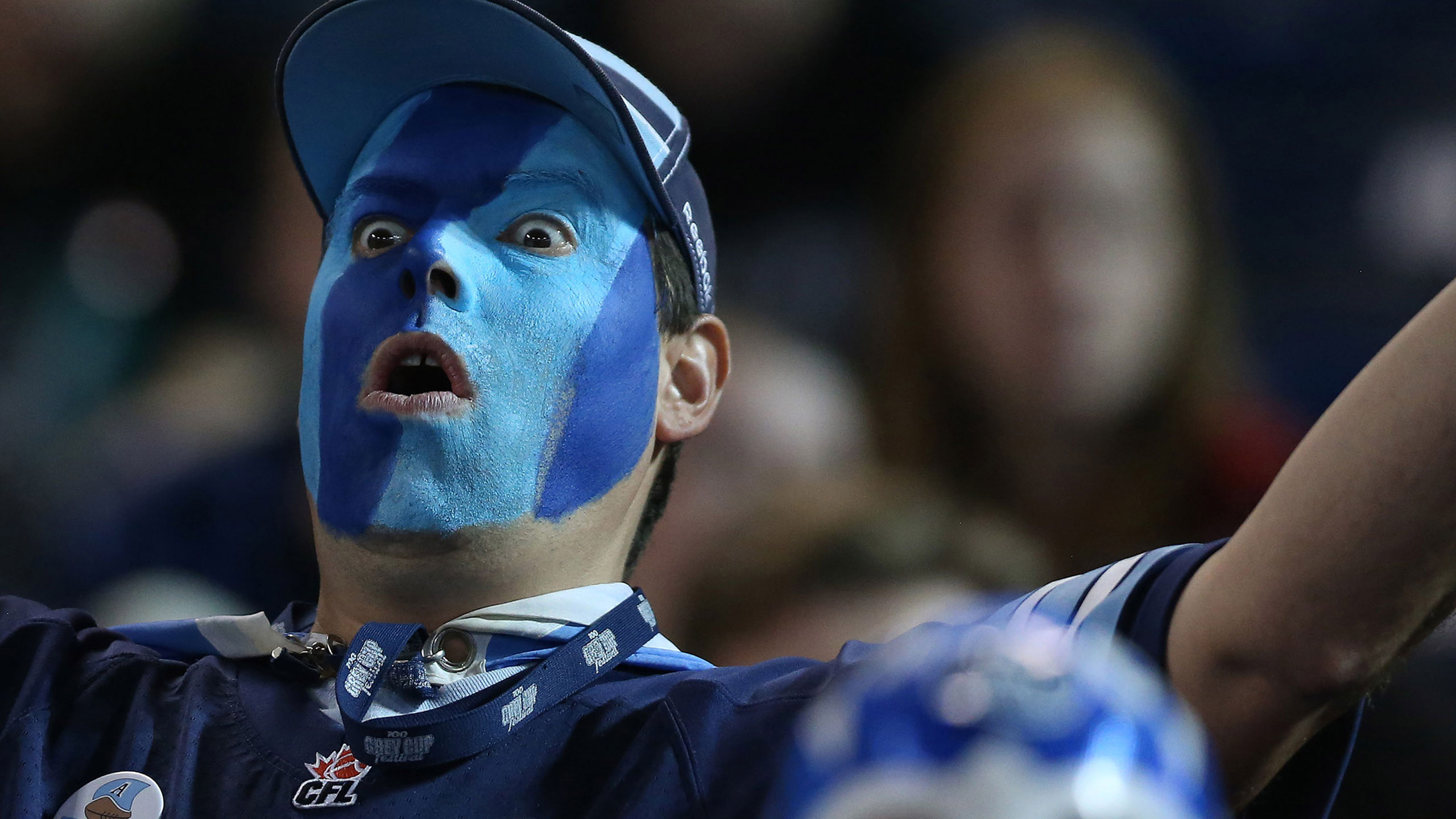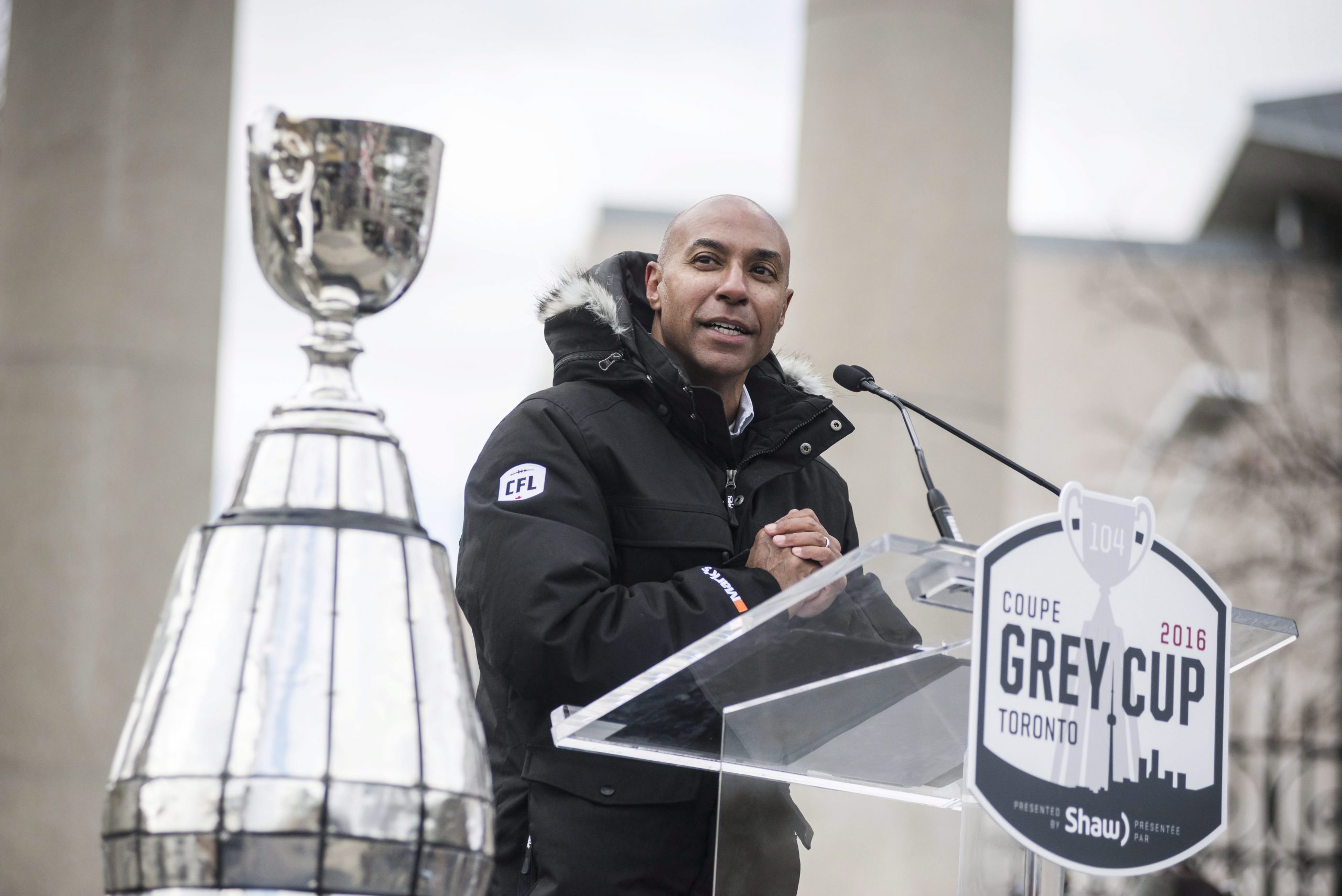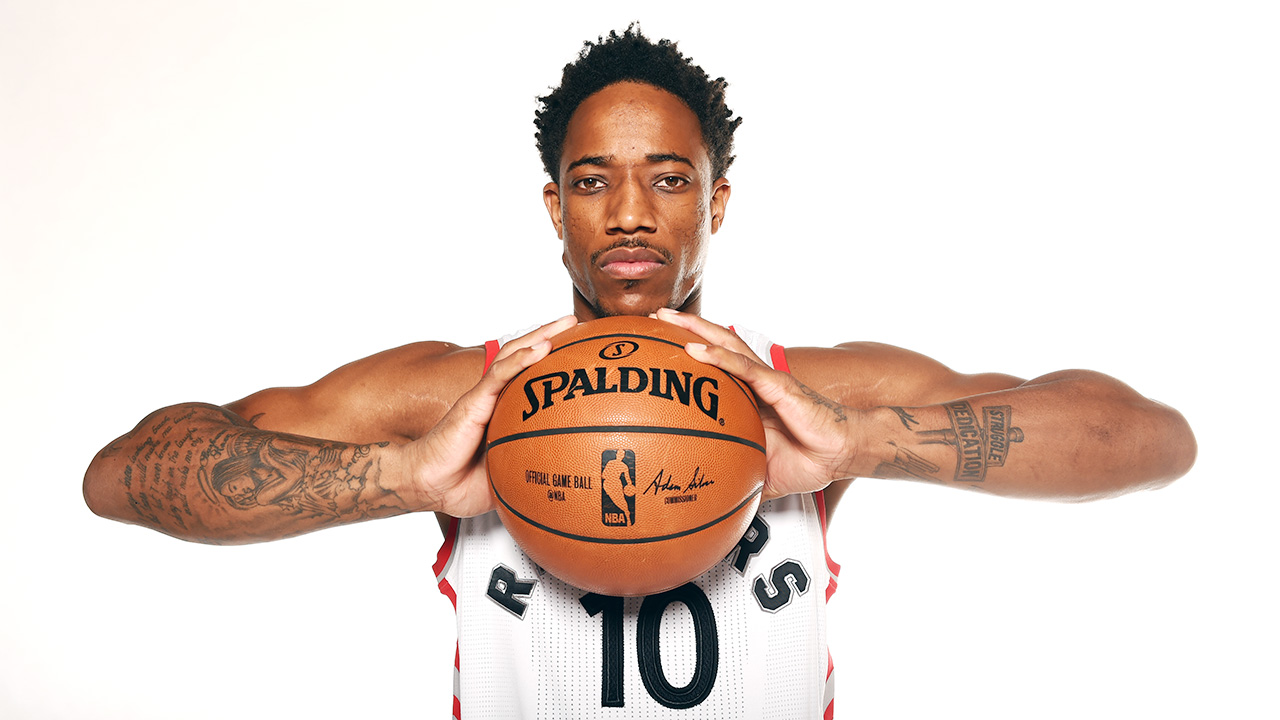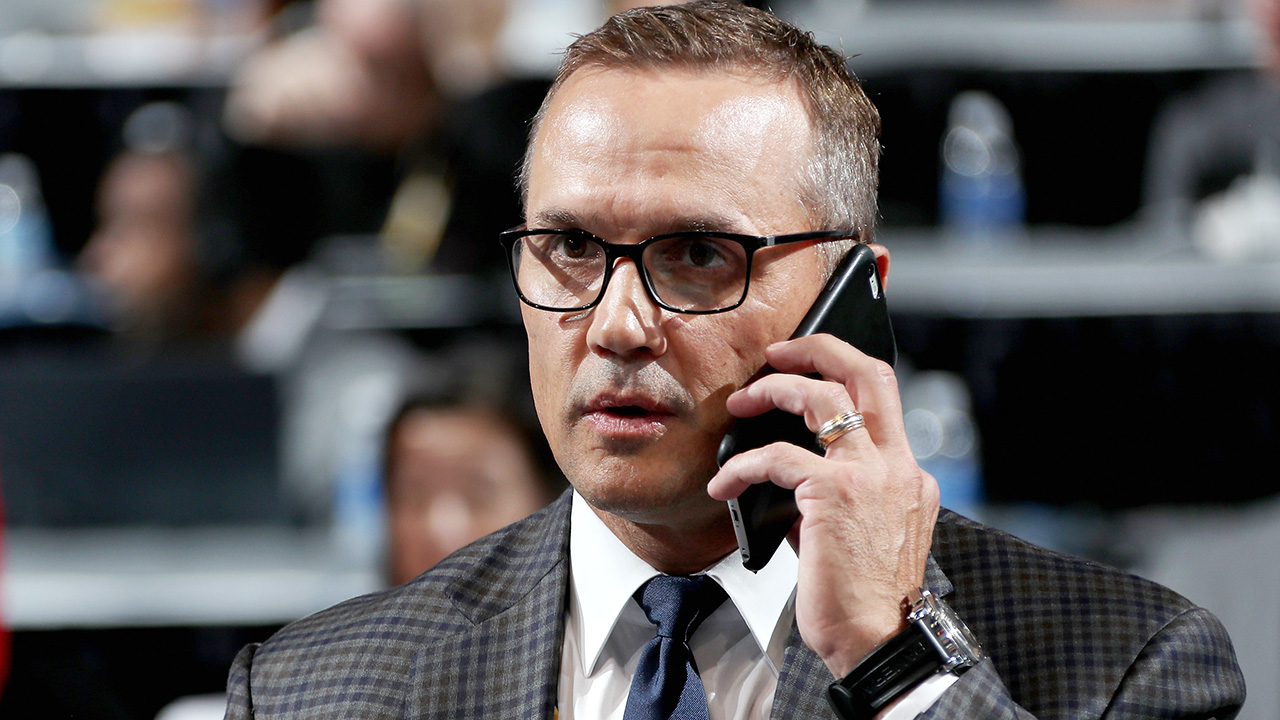Toronto Argonauts defensive back TJ Heath rotates to the safety spot in the middle of the formation on the BMO Field grass, eyes locked on Hamilton quarterback Zach Collaros as he drops back in the pocket. It’s first and 10 on Toronto’s 11-yard line as the defence tries to protect a 12-point lead—a touchdown cuts the advantage to one score with around five minutes left on the clock on the picture-perfect late-summer night. The Ticats’ passer double-clutches a throw across the middle into the end zone for CJ Gable, who leaps but fails to make a miraculous grab. Linebacker Brandon Isaac puts a WWE-style hit on Gable as the ball ricochets to Heath, who makes the difficult, reactionary interception look smooth, then returns it 32 yards.
Heath’s teammates swarm him, knowing how crucial that play was to clinching the game. One of the biggest Argos crowds of the season erupts along with them.
This is what Argos president and CEO Michael Copeland, hired before the 2016 season, was referring to when he vowed to “create some magic” around football in Toronto: A great stadium and environment playing host to a marquee win by a likeable team that you can get behind.
Jaded as fans tend to be to such grandiose statements, for a while at least it seemed like anything was possible for the Argos. A move out of Rogers Centre—where the atmosphere had become stale—to BMO Field was a major step for the Double Blue. And it wasn’t just a new grass field and outdoor setting, either. Toronto city council, led by mayor John Tory, brought tailgating—complete with beer at $4 a can—to Argonauts home games. An off-season full of positive momentum was building towards a season that would culminate with Toronto hosting the 2016 Grey Cup.
But that momentum stopped just as jarringly as Heath’s interception cut down Hamilton’s comeback bid on Sunday, Sept. 11. That day was the defensive back’s 29th birthday. He and spot-starter quarterback Dan LeFevour received game balls for their strong efforts in the win that brought the Argos back to 5-6, in a tie for second place in the East.
“The momentum we got back [[after that win]] and the room feeling good… TJ [Heath] and Dan [LeFevour] delivered emotional speeches that had us all choked up, feeling like a family again,” says a veteran Argos player whose opinion is shared by the leadership group of the team.
Thirty minutes after the speeches ended, however, Heath was notified by Argos head coach Scott Milanovich and general manager Jim Barker that he had been traded—to Winnipeg, along with first- and third-round draft picks, for quarterback Drew Willy.
“The deal was done before the game, I get it, but that’s messed up,” says another Argos player.
A jubilant locker room turned immediately silent as the news made its way to each player.
After that, it was all but over. Toronto lost seven straight games by an average margin of 23 points, finishing last in the East Division at 5-13. In a season where a lot was riding on a successful Argos showing, the team—and the league—wound up with a worst-case scenario.

The bad tidings for the 2016 Argonauts started before the 2015 season had even finished. Throughout that campaign, Trevor Harris started 16 games in place of an injured Ricky Ray, and beat even the most optimistic expectations. But after leading Toronto to a 9-7 record and clinching a playoff spot in a season where the team played four of its nine home games in Fort McMurray, Ottawa and Hamilton, Harris was benched when Ray returned. Ray went 1-1 in the final two regular-season games and lost the Eastern semifinal.
Though Harris struggled with turnovers, especially late in the season, the move to reinstall Ray irked him because it showed a lack of faith from Milanovich. The Argos then made re-signing Ray a priority, announcing his contract extension four days after the 2015 Grey Cup—the deal was likely all but official soon after the Argonauts season ended. That led to Harris signing with the division-rival Redblacks and telling reporters, “I’m just excited to be on a team that really believes in me.” In Ottawa, he formed a quarterback tandem with Henry Burris, and the team’s impressive depth at the position is a major reason why the Redblacks made the 104th Grey Cup at BMO Field.
Two days after Harris signed with Ottawa, things got worse for Toronto when Chad Owens inked a deal with Hamilton. The 2012 CFL MOP had purchased a home in Mississauga with his wife, Rena, and their three children, showing he was clearly committed to the Argos. But prior to the start of free agency, Barker said the team could not pay Owens what he made in the past and made a point of saying a player’s ability to stay healthy is important to him. That struck some as ironic after the dust had settled on the free-agency period—Owens suited up for 13 of the Argos’ 18 games in 2015, while Ray had played in just three.
After deciding to call southern Ontario home, Owens wanted to stay close, making Hamilton a natural fit. On the other side, the Ticats liked the value of signing a productive, big-name receiver for one year at around $80,000. Barker’s fortune-telling powers were correct, with Owens missing the final six games of the 2016 season with a broken foot, but the pass-catcher was productive through 12 games with 808 receiving yards and five touchdowns. And he still played more than Ray, who donned the Double Blue just nine times in 2016, and whose injuries necessitated the trade for Willy.

Losing Harris and Owens hurt the team on the field, but it also left the franchise without a star to market around, which made it tough on the business-operations side. That didn’t deter a confident Copeland, however, who stated that the Argos expected to sell out every game at BMO Field in the team’s inaugural season there.
That goal was nearly achieved in the Argos’ first home game in their new environs. Nearly 25,000 showed out for the CFL season-opener at BMO Field, which has a capacity of 27,600 for football games. And all involved agreed the new venue was a massive step up from Rogers Centre inside and out, with fresh air, barbecues, beer and music creating a long-missing football experience. But whether due to lack of interest in the team or simply too much competition for Toronto sports fans’ attention, attendance quickly dipped to 17,500 or less per game. When the dust cleared, the team had averaged fewer attendees per game than it did for its five Rogers Centre home games in 2015. (That said, season ticket holders nearly doubled.)
The infamous Willy trade—which was made after Ray suffered a fractured rib and partially deflated lung in a Labour Day loss to Hamilton—turned what should have been a rallying point for the team and the fans on its head. And the personnel troubles didn’t stop there. Before that game, the team released starting strong-side linebacker Keon Raymond, who was a defensive captain. Then, on Oct. 3, the team gave pink slips to four receivers—Vidal Hazelton, Tori Gurley, Kevin Elliott and Phil Bates. Team insiders say the group had shown a lack of focus on football and had been consistently late for team obligations, and the move was made to send a message. But the cuts were quickly and roundly criticized. Losing that much talent decimated a receiving corps that had already lost Owens, and cutting just one of them could have potentially done the same job. Instead, each pass catcher found a welcoming new team and the Argos sank some more.
“The coaches tried blaming veterans, cut and benched leaders,” an experienced Argos player says. “Then the room was lost because players who haven’t been here or earned it became empowered. When that didn’t work they tried blaming the young guys. When that didn’t work they went back to calling out the veterans in front of the whole team. You can’t do that because you kill leadership.”
That erosion of leadership might cost Milanovich his job with Toronto. Sources around the league say that the 43-year-old could be relieved of his head coaching duties once the Grey Cup news moratorium ends.
“Scott [Milanovich] honestly lost the room—worst locker room I’ve ever been a part of,” a current Argo states. “The one group who never got blamed and never accepted responsibility was the coaches—it was always the players’ fault. To the media they said the right things to take blame, but in the room they never did. They never made us feel like we were in this together. It created an environment of veterans not trusting coaches, coaches not trusting veterans, and young players’ heads spinning with what to do and who to go to for guidance.”

It seems obvious that changes need to happen within the coaching staff. Copeland alluded to as much in a letter to season-ticket holders.
“We are currently performing a comprehensive review of all aspects of our football operations,” Copeland wrote. “We will establish a stronger foundation for the on-field success not only for 2017, but in every year that follows.”
While some players feel that change in the coaching ranks is necessary, many feel differently about Barker and the football personnel group.
“I feel bad for Jim [Barker],” an Argos player says. “He deserves another year to turn it around.”
Players believe that if the 60-year-old GM can find the right mix within the coaching staff—even if Milanovich, still viewed as a man with a progressive football mind, stays—and an answer at quarterback, then good things can happen on the field. And if the head-coaching job comes open, expect Ticats defensive coordinator Orlondo Steinauer—2004 Grey Cup champion as a defensive back with Toronto—to be a lead candidate. Barker hired the defensive guru for his first CFL coaching job with the Argos in 2010.
In the larger picture, it’s a pretty open secret: The CFL needs the Argos to be a successful—or at least viable—franchise in order for the league to resonate in the largest market in Canada. If it languishes in Toronto, where many of the big-money investors reside, that could be detrimental to financial stability.
“It needs to turn around here or the league is in trouble,” adds an Argos player.
But getting there won’t be easy. All the pieces were in place at the start of the 2016 season, and neither wins nor fans consistently materialized. And so the team will start next season in a very similar position to last: With an environment built for success, but in need of a winner.





